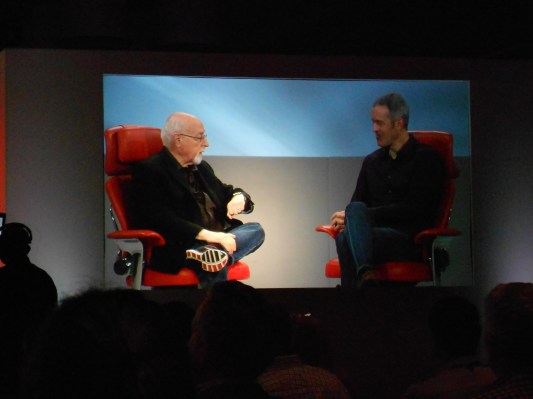Jeff Williams, Apple’s senior vice president of operations, said that there are over 4,000 apps now available for Apple Watch, a number we’ve previously heard. Williams also discussed the upcoming native SDK for the Apple Watch. Williams spoke in an interview today at the Code conference in Rancho Palos Verdes, Calif.
“A week from Monday at our developer conference we’ll release a preview so that developers will be able to write code natively and have access to sensors, and we’re really excited about that.”
When asked by TechCrunch about the possibility of future Apple Watches giving more transparency to overall health, Williams declined to say anything specific but did acknowledge that Apple was considering adding more sensors.
Though Williams spent most of the time talking about Apple Watch and the supply chain, he also did coyly refer to Apple’s interest in other areas, noting that “the car is the ultimate mobile device isn’t it?”
Williams says that he wore Android Wear watches and other devices for short periods of time but it “didn’t really help them” decide what they wanted to do in the space. Current Apple Watch apps are unable to access sensors on the Watch directly and do not actually run on the Watch, but project their interfaces to its screen from the iPhone. More capable apps will be able to be designed for the Watch once the native SDK — which has many of the functions Apple used to make its own apps — is released at next month’s WWDC conference.
Though many had assumed that direct access to the Watch sensors would be part of that package, this is the first confirmation we’ve had that this will be part of the native development kit’s capabilities.
What this means for consumers is quicker, more capable Watch apps that could feel less sluggish and offer more interesting feature sets. Williams says apps like that should be hitting in the fall after developers have had time to dig into the ‘preview’ SDK.
“Customers love the Apple Watch, more so than I ever thought. I thought it was going to take a little bit of time because millenials don’t use watches. We entered into a space where the products weren’t great. People love the utility of it.”
Customers are praising the utility of it, says Williams. When asked how many watches had been sold, Williams said “a lot, but not enough. The only number I’ll give you is that demand divided by supply is greater than 1,” joked Williams.
“The decision was that it was a new category — we’ll see how it goes over time; if it reaches the materiality position then we’ll think about it,” said Williams in reference to why they didn’t disclose sales numbers for the Watch.
“There’s great inevitability to technology moving to your body,” said Williams about the future of wearable computing. Williams said Apple chose the wrist very deliberately before outlining a history of the clock moving to the watch moving to the wrist — bringing up the aviator friend of Cartier who needed a more convenient way of telling the time while flying.
As an example of direct access via an Apple Watch SDK, Williams brought up the Strava app that could get data directly from the sensors on the Watch.
Williams, though a 20-year veteran of Apple, has only recently been pushed into the limelight by the company. As SVP of operations, Williams essentially took over the role occupied by now CEO Tim Cook — big shoes to fill.
Recently, Williams has had to source and construct a supply chain for the Apple Watch, the company’s first completely new product line in five years. In addition to ops, he’s heavily involved in making sure acquisitions are up to snuff and managing suppliers. Williams has been bandied about as a possible CEO successor for years now.
The recent Apple Watch event also revealed that Williams, a fitness buff like Tim Cook, had also been working on ResearchKit, an open-source health initiative that allows hospitals and researchers to use iPhones to perform health-related patient research.
ResearchKit, though a small component of the Apple Watch launch, could actually give Apple a major toehold in the medical industry and, if properly open, may change health research substantially for the better.
Williams has appeared more on stage recently, in keeping with Tim Cook’s ‘cast of characters’ approach to keynotes. The willingness to share the spotlight is just one of Cook’s many operational changes to Apple, but one of the most easily spotted. Williams is formidable, intelligent and well-respected with everyone I’ve spoken to inside and outside of Apple. Other execs have their doubters and detractors, but Williams is rarely among them.
